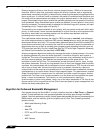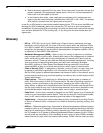
Firewall Settings > QoS Mapping
769
SonicOS 5.8.1 Administrator Guide
e. Since all the queues have been processed for GBW we now move onto use up the left
over link credit of 8000.
f. Start off with the highest priority 0 and process all queues in this priority in a round robin
fashion. H323 has Pkt3 of 500B which is sent since it can use up to max = 2560 (MBW-
GBW). Now Link credit = 7500 and max = 2060.
g. Move to the next queue in this priority which is VNC queue. Pkt3 of 500B is sent out
leaving link credit = 7000B and class max = 140 (MBW-GBW - 500).
h. Move to the next queue in this priority. Since H323 queue is empty already we move to
the next queue which is VNC again.
i. From VNC queue Pkt4 of 40B is sent out leaving link credit = 6960 and class max =
100. Pkt5 of 500B is not sent since class max is not enough.
j. Now we move onto next lower priority queue. Since priorities 1 through 3 are empty we
choose priority 4 which has the rule queue for FTP. Pkt2 of 1000B is sent which leaves
with link credit = 6000 and class max = 280. Since there are no other queues in this
priority, FTP queue is processed again. But since class max is not enough for Pkt3 of
1500B it is not sent.
k. Move to the next lower priority which is 7 for Yahoo Messenger. Pkt1 of 1200B is sent
leaving link credit = 4800 and class max = 80. Since no other queues exist in this
priority, this queue is processed again. Pkt2 of 1500B is not sent since it cannot be
accommodated with max = 80.
l. At this point, all the queues under all priorities are processed for the current time slice.
Inbound Bandwidth Management
Inbound BWM can be used to shape inbound TCP and UDP traffic. TCP’s intrinsic flow control
behavior is used to manage ingress bandwidth. To manage inbound UDP traffic, CBQ is used
by the ingress module to queue the incoming packets. TCP rate is inherently controlled by the
rate of receipt of ACKs; i.e. TCP sends out packets out on the network at the same rate as it
receives ACKs. For IBWM, the sending rate of a TCP source will be reduced by controlling the
rate of ACKs to the source. By delaying an ACK to the source, round-trip time (RTT) for the flow
is increased, thus reducing the source’s sending rate.


















